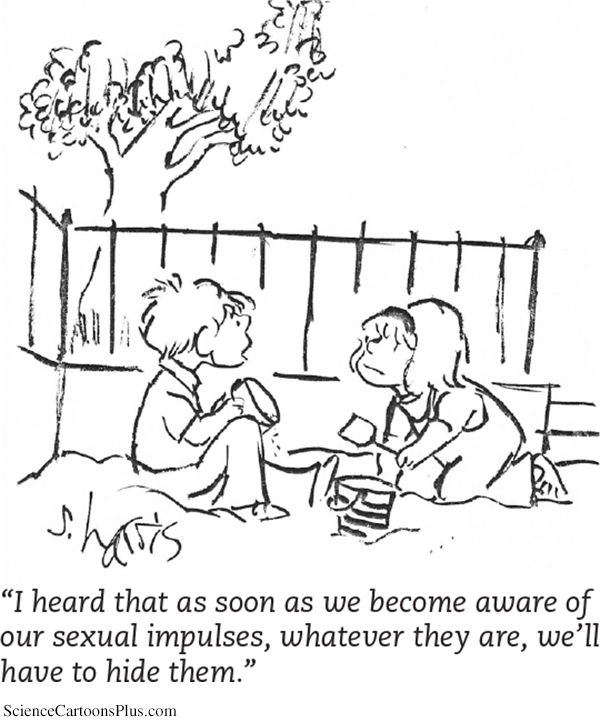12.2 Psychodynamic Theories
psychodynamic theories view personality with a focus on the unconscious and the importance of childhood experiences.
Psychoanalysis Freud’s theory of personality that attributes thoughts and actions to unconscious motives and conflicts; the techniques used in treating psychological disorders by seeking to expose and interpret unconscious tensions.
Psychodynamic theories of personality view human behavior as a lively (dynamic) interaction between the conscious and unconscious mind, and they consider our related motives and conflicts. These theories came from Sigmund Freud’s psychoanalysis—his theory of personality and the associated treatment techniques. Freud’s work was the first to focus clinical attention on our unconscious mind.
Freud’s Psychoanalytic Perspective: Exploring the Unconscious
LOQ 12-
Freud was not psychology’s most important figure, but he is definitely the most famous. Ask 100 people on the street to name a deceased psychologist, suggested Keith Stanovich (1996, p. 1), and “Freud would be the winner hands down.” His influence lingers in books, movies, and psychological therapies. Who was Freud, what did he teach, and why do we still study his work?
Like all of us, Sigmund Freud was a product of his times. His Victorian era was a time of great discovery and scientific advancement, but it is also known today as a time of sexual repression and male dominance. Men’s and women’s roles were clearly defined, with male superiority assumed and only male sexuality generally acknowledged (discreetly).
After graduating from the University of Vienna medical school, Freud specialized in nervous disorders. Before long, he began hearing complaints that made no medical sense. One patient had lost all feeling in one hand. Yet there is no nerve pathway that, if damaged, would numb the entire hand and nothing else. Freud wondered: What could cause such disorders? His search for the answer led in a direction that would challenge our self-
Unconscious according to Freud, a reservoir of mostly unacceptable thoughts, wishes, feelings, and memories. According to contemporary psychologists, information processing of which we are unaware.

Could these strange disorders have mental rather than physical causes? Freud decided they could. Many meetings with patients led to Freud’s “discovery” of the unconscious. In Freud’s view, this deep well keeps unacceptable thoughts, wishes, feelings, and memories hidden away so thoroughly that we are no longer aware of them. But despite our best efforts, bits and pieces of these ideas seep out. Thus, according to Freud, patients might have an odd loss of feeling in their hand because they have an unconscious fear of touching their genitals. Or their unexplained blindness might be caused by unconsciously not wanting to see something that makes them anxious.
Basic to Freud’s theory was his belief that the mind is mostly hidden. Below the surface lies a large unconscious region where unacceptable passions and thoughts lurk. Freud believed we repress these unconscious feelings and ideas. We block them from awareness because admitting them would be too unsettling. Nevertheless, he said, these repressed feelings and ideas powerfully influence us.
“I know how hard it is for you to put food on your family.”
Former U.S. President George W. Bush, 2000
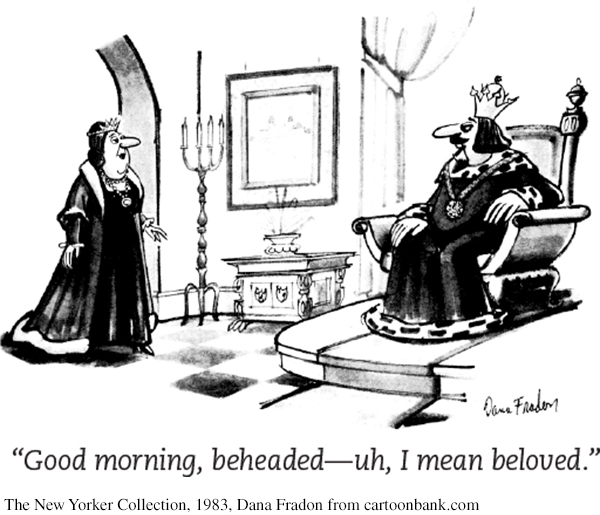
For Freud, nothing was ever accidental. He saw the unconscious seeping not only into people’s troubling symptoms but also, in disguised forms, into their work, their beliefs, and their daily habits. He also glimpsed the unconscious in slips of the tongue and pen, as when a financially stressed patient, not wanting any large pills, said, “Please do not give me any bills, because I cannot swallow them.” Jokes, too, were expressions of repressed sexual and aggressive tendencies traveling in disguise. Dreams, he said, were the “royal road to the unconscious.” He thought the dreams we remember are really censored versions of our unconscious wishes.
free association in psychoanalysis, a method of exploring the unconscious in which the person relaxes and says whatever comes to mind, no matter how unimportant or embarrassing.
Hoping to unlock the door to the unconscious, Freud first tried hypnosis, but with poor results. He then turned to free association, telling patients to relax and say whatever came to mind, no matter how unimportant or silly. Freud believed that free association would trace a path from the troubled present into a patient’s distant past. The chain of thought would lead back to the patient’s unconscious, the hiding place of painful past memories, often from childhood. His goal was to find these forbidden thoughts and release them.
Personality Structure
LOQ 12-
In Freud’s view, human personality arises from a conflict between impulse and restraint. People who evolved from “lower animals” are born with aggressive, pleasure-
To understand the mind’s conflicts, Freud proposed three interacting systems: the id, ego, and superego. Psychologists have found it useful to view the mind’s structure as an iceberg (FIGURE 12.1).
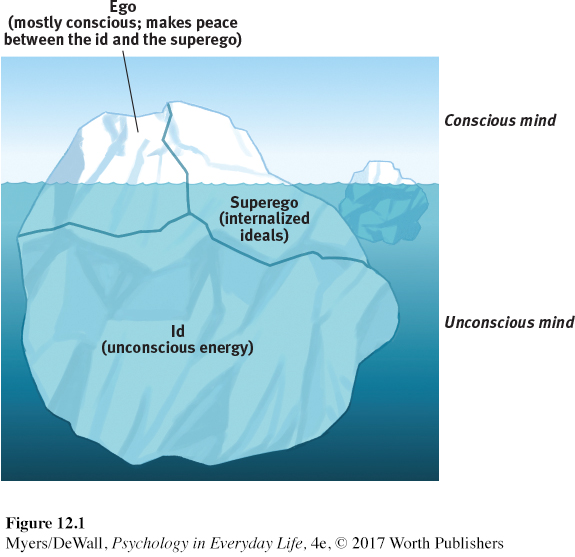
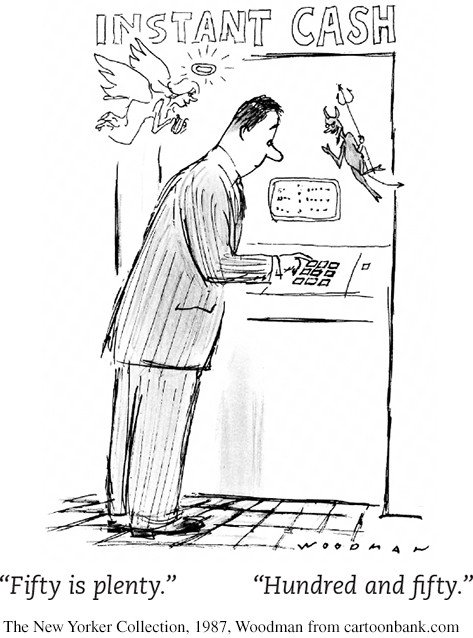
Id a reservoir of unconscious psychic energy that, according to Freud, strives to satisfy basic sexual and aggressive drives. The id operates on the pleasure principle, demanding immediate gratification.
The id stores unconscious energy. It tries to satisfy our basic drives to survive, reproduce, and act aggressively. The id operates on the pleasure principle: It seeks immediate gratification. To understand the id’s power, think of newborn infants crying out the moment they feel a need, wanting satisfaction now. Or think of people who abuse drugs, partying now rather than sacrificing today’s temporary pleasure for future success and happiness (Fernie et al., 2013; Friedel et al., 2014; Keough et al., 1999).
Ego the largely conscious, “executive” part of personality that, according to Freud, balances the demands of the id, superego, and reality. The ego operates on the reality principle, satisfying the id’s desires in ways that will realistically bring pleasure rather than pain.
The mind’s second part, the ego, operates on the reality principle. The ego is the conscious mind. It tries to satisfy the id’s impulses in realistic ways that will bring long-
Superego the part of personality that, according to Freud, represents internalized ideals and provides standards for judgment (the conscience) and for future goals.
As the ego develops, the young child learns to cope with the real world. Around age 4 or 5, Freud theorized, a child’s ego begins to recognize the demands of the superego, the voice of our moral compass, or conscience. The superego forces the ego to consider not only the real but also the ideal. It focuses on how one ought to behave in a perfect world. It judges actions and produces positive feelings of pride or negative feelings of guilt.
As you may have guessed, the superego’s demands often oppose the id’s. It is the ego’s job to reconcile the two. As the personality’s “executive,” the ego juggles the impulsive demands of the id, the restraining demands of the superego, and the real-
Personality Development
LOQ 12-
psychosexual stages the childhood stages of development (oral, anal, phallic, latency, genital) during which, according to Freud, the id’s pleasure-
Freud believed that personality forms during life’s first few years. He was convinced that children pass through a series of psychosexual stages, from oral to genital (TABLE 12.1). In each stage, the id’s pleasure-

| Stage | Focus |
|---|---|
| Oral (0– |
Pleasure centers on the mouth— |
| Anal (18– |
Pleasure focuses on bowel and bladder elimination; coping with demands for control |
| Phallic (3– |
Pleasure zone is the genitals; coping with incestuous sexual feelings |
| Latency (6 to puberty) | A phase of dormant sexual feelings |
| Genital (puberty on) | Maturation of sexual interests |
Oedipus [ED-
Freud believed that during the third stage, the phallic stage, boys develop unconscious sexual desires for their mother. They also feel jealousy and hatred for their father, who is a rival for their mother’s attention. These feelings lead to guilt and a lurking fear that their father will punish them, perhaps by castration. Freud called this cluster of feelings the Oedipus complex, after the Greek legend of Oedipus, who unknowingly killed his father and married his mother. Some psychoanalysts in Freud’s era believed that girls experience a parallel Electra complex.
Identification the process by which, according to Freud, children incorporate their parents’ values into their developing superegos.
Children learn to cope with these feelings by repressing them, said Freud. They identify with the “rival” parent and try to become like him or her. It’s as though something inside the child decides, “If you can’t beat ’em, join ’em.” This identification process strengthens children’s superegos as they take on many of their parents’ values. Freud believed that identification with the same-
Fixation in personality theory, according to Freud, a lingering focus of pleasure-
Other conflicts could arise at other childhood stages. But whatever the stage, unresolved conflicts can cause trouble in adulthood. The result, Freud believed, would be fixation, locking the person’s pleasure-
Defense Mechanisms
LOQ 12-
defense mechanisms in psychoanalytic theory, the ego’s protective methods of reducing anxiety by unconsciously distorting reality.
Repression in psychoanalytic theory, the basic defense mechanism that banishes from consciousness the thoughts, feelings, and memories that arouse anxiety.
Anxiety, said Freud, is the price we pay for civilization. As members of social groups, we must control our sexual and aggressive impulses, not act them out. Sometimes the ego fears losing control of this inner war between the id and superego, which results in a dark cloud of generalized anxiety. We feel unsettled, but we don’t know why.
Freud proposed that the ego distorts reality in an effort to protect itself from anxiety. Defense mechanisms help achieve this goal by disguising threatening impulses and preventing them from reaching consciousness. Note that, for Freud, all defense mechanisms function indirectly and unconsciously. Just as the body unconsciously defends itself against disease, so also does the ego unconsciously defend itself against anxiety. For example, repression banishes anxiety-
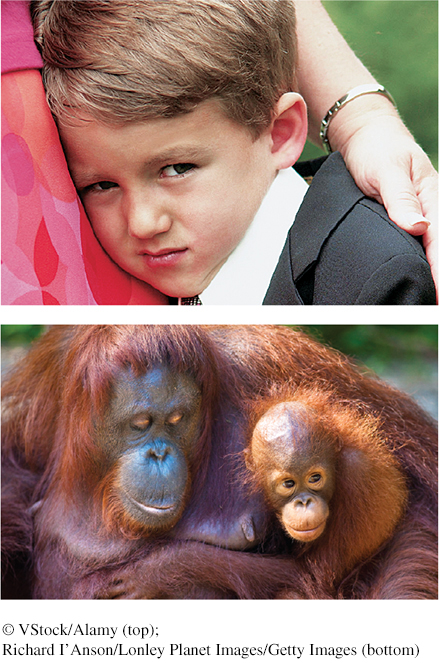
|
Freud believed that repression, the basic mechanism that banishes anxiety- |
||
| Defense Mechanism | Unconscious Process Employed to Avoid Anxiety- |
Example |
|---|---|---|
| Regression | Retreating to a more infantile psychosexual stage, where some psychic energy remains fixated. | A little boy reverts to the oral comfort of thumb sucking in the car on the way to his first day of school. |
| Reaction formation | Switching unacceptable impulses into their opposites. | Repressing angry feelings, a person displays exaggerated friendliness. |
| Projection | Disguising one’s own threatening impulses by attributing them to others. | “The thief thinks everyone else is a thief” (an El Salvadoran saying). |
| Rationalization |
Offering self- |
A habitual drinker says she drinks with her friends “just to be sociable.” |
| Displacement | Shifting sexual or aggressive impulses toward a more acceptable or less threatening object or person. | A little girl kicks the family dog after her mother puts her in a time- |
| Denial | Refusing to believe or even perceive painful realities. | A partner denies evidence of his loved one’s affair. |
Retrieve + Remember
Question 12.1
•According to Freud’s ideas about the three-
ANSWERS: ego; id; superego
Question 12.2
•In the psychoanalytic view, conflicts unresolved during one of the psychosexual stages may lead to _____ at that stage.
ANSWER: fixation
Question 12.3
•Freud believed that our defense mechanisms operate _____ (consciously/unconsciously) and defend us against _____.
ANSWERS: unconsciously; anxiety
The Neo-Freudian and Later Psychodynamic Theorists
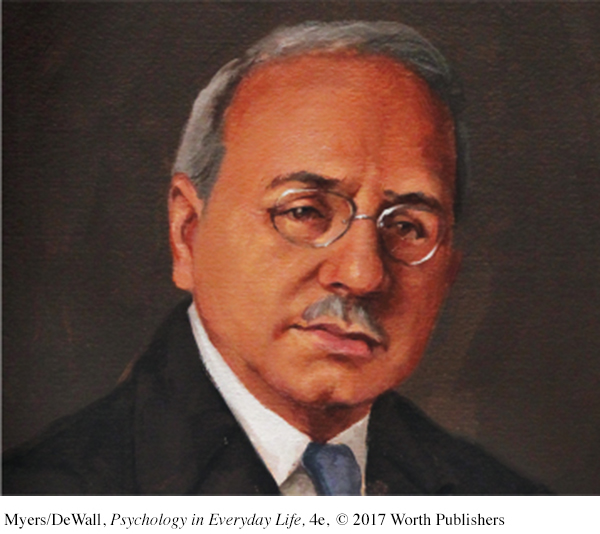
LOQ 12-
Freud’s writings caused a lot of debate. Remember that Freud lived at a time when people seldom talked about sex, and certainly not unconscious sexual desires for one’s parent. So it’s no surprise that Freud was harshly criticized. In a letter to a trusted friend, Freud wrote, “In the Middle Ages, they would have burned me. Now they are content with burning my books” (Jones, 1957). Despite the controversy, Freud attracted followers. Several young, ambitious physicians formed an inner circle around the strong-
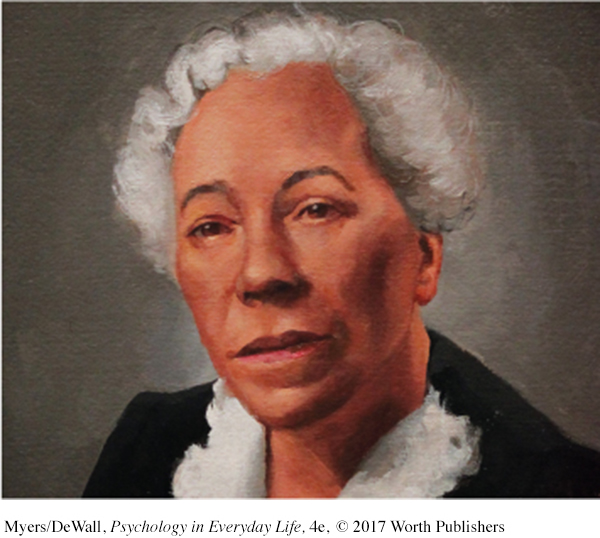
Personality has three parts: id, ego, and superego.
The unconscious is key.
Personality forms in childhood.
We use defense mechanisms to ward off anxiety.
“We don’t see things as they are; we see things as we are.”
The Talmud
But the neo-
collective unconscious Carl Jung’s concept of a shared, inherited group of memories from our species’ history.
Jung believed that we have a collective unconscious, a common group of images, or archetypes, that developed from our species’ universal experiences. Jung said that the collective unconscious explains why, for many people, spiritual concerns are deeply rooted and why people in different cultures share certain myths and images. Most of today’s psychologists disagree with the idea of inherited experiences. But they do believe that our shared evolutionary history shaped some universal dispositions and that experience can leave epigenetic marks—
Some of Freud’s ideas have been incorporated into the diverse perspectives that make up modern psychodynamic theory. Theorists and clinicians who study personality from a psychodynamic perspective assume, with Freud and with much support from today’s psychological science, that much of our mental life is unconscious. They believe we often struggle with inner conflicts among our wishes, fears, and values, and respond defensively. And they agree that childhood shapes our personality and ways of becoming attached to others. But in other ways, they differ from Freud. “Most contemporary [psychodynamic] theorists and therapists are not wedded to the idea that sex is the basis of personality,” noted psychologist Drew Westen (1996). They “do not talk about ids and egos, and do not go around classifying their patients as oral, anal, or phallic characters.”
 For a helpful, 9-
For a helpful, 9-
Assessing Unconscious Processes
LOQ 12-
projective test a personality test, such as the Rorschach, that provides an ambiguous image designed to trigger projection of the test-
Thematic Apperception Test (TAT) a projective test in which people express their inner feelings and interests through the stories they make up about ambiguous scenes.
Personality tests reflect the basic ideas of particular personality theories. So, what might be the assessment tool of choice for someone working in the Freudian tradition?
To find a way into the unconscious mind, you would need a sort of “psychological X-
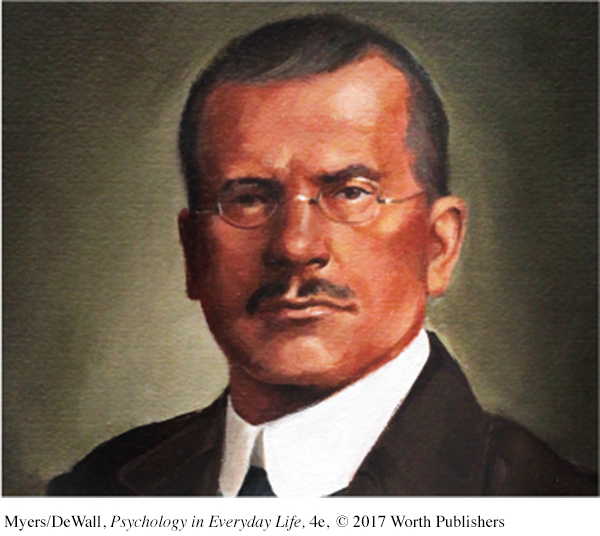
Rorschach inkblot test the most widely used projective test; a set of 10 inkblots, designed by Hermann Rorschach; seeks to identify people’s inner feelings by analyzing their interpretations of the blots.
The most famous projective test, the Rorschach inkblot test, was introduced in 1921. Swiss psychiatrist Hermann Rorschach [ROAR-
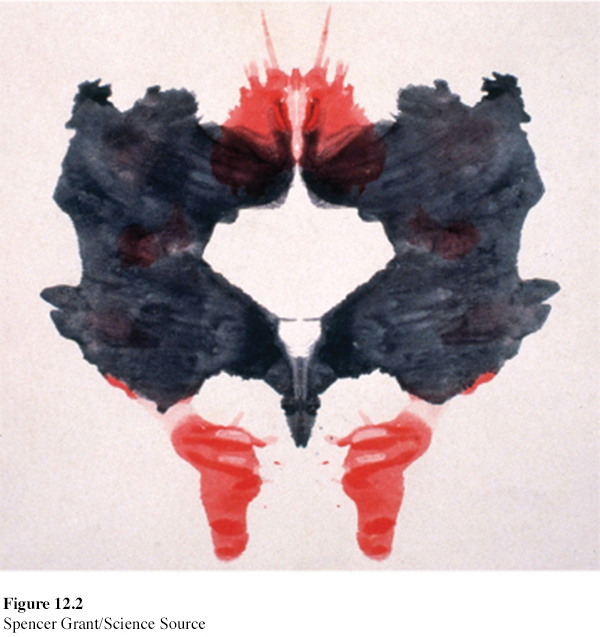
Is this a reasonable assumption? Let’s see how well the Rorschach test measures up to the two primary criteria of a good test (Chapter 8):
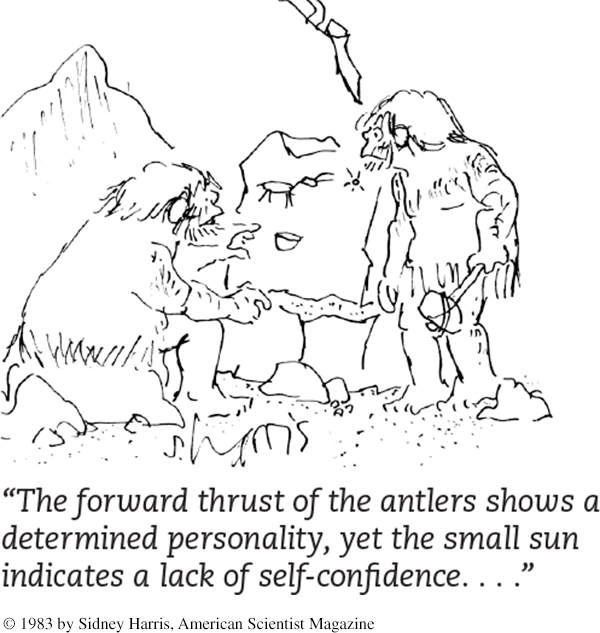
Reliability (consistency of results): Raters trained in different Rorschach scoring systems show little agreement (Sechrest et al., 1998).
Validity (predicting what it’s supposed to): The Rorschach test is not very successful at predicting behavior or at discriminating between groups (for example, identifying who is suicidal and who is not). Inkblot results have diagnosed many normal adults as disordered (Wood, 2003; Wood et al., 2006).
The Rorschach test has neither much reliability nor great validity. But some clinicians value it as a source of suggestive leads, an icebreaker, or a revealing interview technique. Thus, the Rorschach test appears to have “the dubious distinction of being simultaneously the most cherished and most reviled of all psychological assessment instruments” (Hunsley & Bailey, 1999, p. 266).
Evaluating Freud’s Psychoanalytic Perspective and Modern Views of the Unconscious
LOQ 12-
“Many aspects of Freudian theory are indeed out of date, and they should be: Freud died in 1939, and he has been slow to undertake further revisions,” observed one researcher (Westen, 1998). In Freud’s time, there were no neurotransmitter or DNA studies. Decades of scientific breakthroughs in human development, thinking, and emotion were yet to come. Criticizing Freud’s theory by comparing it with current concepts is therefore, some say, like comparing Henry Ford’s Model T with today’s hybrid cars. (How tempting it always is to judge people in the past from our perspective in the present.)
But Freud’s admirers and critics agree that recent research contradicts many of his specific ideas. Developmental psychologists now see our development as lifelong, not fixed in childhood. They doubt that infant brain networks are mature enough to process emotional trauma in the ways Freud assumed. Some think Freud overestimated parental influence and underestimated peer influence (and abuse). They also doubt that conscience and gender identity form as the child resolves the Oedipus complex at age 5 or 6. Our gender identity develops much earlier, and we become masculine or feminine even without a same-
Freud believed that dreams were the royal road to the unconscious, but they aren’t. Modern dream researchers disagree with Freud’s idea that dreams disguise unfulfilled wishes lurking in our unconscious (Chapter 2). And slips of the tongue can be explained as competition between similar word choices in our memory network. Someone who says, “I don’t want to do that—
Psychology’s strength comes from its use of the same scientific method that biologists, chemists, and physicists use to test their theories. Psychologists must ask the same question about Freud’s theory that they ask about other theories. Remember that a good theory organizes observations and predicts behaviors or events (Chapter 1). How does Freudian theory stand up to the scientific tests?
Freud’s theory rests on few objective observations, and it has produced few hypotheses to verify or reject. For Freud, his own interpretations of patients’ free associations, dreams, and slips of the tongue were evidence enough. Moreover, say the critics, Freud’s theory offers after-
Freud’s supporters object. To criticize Freudian theory for not making testable predictions is, they say, like criticizing baseball for not being an aerobic exercise, something it was never intended to be. Freud never claimed that psychoanalysis was predictive science. He merely claimed that, looking back, psychoanalysts could find meaning in their clients’ mental state (Rieff, 1979).
Freud’s supporters also note that some of his ideas are enduring. It was Freud who drew our attention to the unconscious and the irrational, when such ideas were not popular. Today many researchers study our irrationality (Ariely, 2010; Thaler, 2015). Psychologist Daniel Kahneman won a 2002 Nobel Prize with his studies of our faulty decision making. Freud also drew our attention to the importance of human sexuality. He made us aware of the tension between our biological impulses and our social well-
Modern Research Challenges the Idea of Repression
Psychoanalytic theory hinges on the assumption that our mind often represses offending wishes. Repression supposedly banishes emotions into the unconscious until they resurface, like long-
Some researchers believe that extreme, prolonged stress, such as the stress some severely abused children experience, might disrupt memory by damaging the hippocampus (Schacter, 1996). But the far more common reality is that high stress and associated stress hormones enhance memory. Indeed, rape, torture, and other traumatic events haunt survivors, who experience unwanted flashbacks. They are seared onto the soul. “You see the babies,” said Holocaust survivor Sally H. (1979). “You see the screaming mothers. You see hanging people. You sit and you see that face there. It’s something you don’t forget.”
The Modern Unconscious Mind
LOQ 12-
Freud was right that we have limited access to all that goes on in our mind (Erdelyi, 1985, 1988, 2006; Kihlstrom, 1990). Our two-
the right-
hemisphere brain activity that enables the split- brain patient’s left hand to carry out an instruction the patient cannot verbalize (Chapter 2). the parallel processing of different aspects of vision and thinking, and the schemas that automatically control our perceptions and interpretations (Chapter 5).
the implicit memories that operate without our conscious recall, even among those with amnesia (Chapter 7).
the emotions we experience instantly, before conscious analysis (Chapter 9).
the self-
concept and stereotypes that automatically and unconsciously influence how we process information about ourselves and others (Chapter 11).
More than we realize, we fly on autopilot. Unconscious processing happens constantly. Like an enormous ocean, the unconscious mind is huge.
Research also supports two of Freud’s defense mechanisms. For example, one study demonstrated reaction formation (trading unacceptable impulses for their opposite). Men who reported strong anti-
Freud’s projection (attributing our own threatening impulses to others) has also been confirmed. People do tend to see their traits, attitudes, and goals in others (Baumeister et al., 1998b; Maner et al., 2005). Today’s researchers call this the false consensus effect—the tendency to overestimate the extent to which others share our beliefs and behaviors. People who binge-
Retrieve + Remember
Question 12.4
•What are three big ideas that have survived from Freud’s psychoanalytic theory? What are three ways in which Freud’s theory has been criticized?
ANSWER: Freud is credited with first drawing attention to (1) the importance of childhood experiences, (2) the existence of the unconscious mind, and (3) our self-
Question 12.5
•Which elements of traditional psychoanalysis have modern-
ANSWER: Today’s psychodynamic theories still tend to focus on childhood experiences and attachments, unresolved conflicts, and unconscious influences. However, they are not likely to focus on fixation at any psychosexual stage, or the idea that sexual issues are the basis of our personality.
